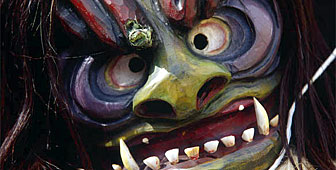
The secrets behind the Lötschen valley masks

In the Lötschen valley, carnival is a dark, almost sinister affair - far from the joyous and colourful festivals celebrated in the rest of Switzerland. Thanks to the valley's isolation, the ancient "Tschäggätta" custom has survived.
In the weeks leading up to Ash Wednesday, groups of terrifying creatures wearing sheep or goatskins roam like restless spirits in the Lötschen valley.
The narrow stretch of land lies between the peaks of the Bernese Oberland and canton Valais, and was cut off from the rest of the world until the arrival of the Lötschberg railway tunnel at the beginning of the 20th century.
The Tschäggätta appear after dusk, rattling cowbells strapped to their waists, and preying on young women, whom they mark with soot smeared on their gloves.
Little is known of the origins of the custom, but not surprisingly the people of the valley were a superstitious lot, who refused to let Christian beliefs get in the way of their pagan rituals.
Today the Tschäggätta come alive through their masks – each one a unique expression of the wildest, and in some cases darkest fantasies of the people of the valley.
“I believe the masks are alive. I talk to them,” says Ernst Rieder, the best-known mask carver in the valley. “Some of the masks we keep in the cellar laugh at me when I talk to them, others smile, others are angered.”
Rieder’s workshop is housed in a traditional wooden chalet – the outside walls protected by oversized masks. Inside his wife, Agnes, chisels a mouth out of a piece of native Arve wood. Frightening faces hanging from the wall behind her look on suspiciously.
“We’ll put in cow or horse teeth when it’s finished. One has to have a good imagination,” says Agnes Rieder-Jerjen. “I picture a face, and then I make the image out of wood. It’s something not anyone can do.”
One of the masks boasts a long chin that curls up like a bent finger to meet a hooked nose.
Now in his 70s, Ernst Rieder grew up with the Tschäggätta, but only returned to mask making in middle age because he feared the tradition was being lost.
“The art had almost died out then. But now the valley is full of young people who make the masks, and beautiful masks at that,” he says.
His only objection is that the younger generation of mask-makers prefer “modern masks that are copies of characters from horror films. Those aren’t the Lötschental originals. It’s a naïve craft that even a schoolboy can do. But it’s an art to create such wonderful facial expressions.”
According to tradition, only single men are allowed to don the Tschäggätta mask and dress. However, the custom has changed with the times, and women now take part. There’s also a daytime procession to mark the end of the festival.
“The tradition is part of our modern life,” says 22-year-old Doris Ritler, who dresses up as one of the Tschäggätta along with her boyfriend. “Anthropologists say that traditions can keep with the times. It’s now commonplace that women and men do everything together, so why not?”
Ritler is one of the many young people who have returned to the valley after seeing the world, drawn back by opportunities in the tourist industry in a region still proud of its traditions. The valley is an insider’s tip for alpine skiing in winter, and hiking in summer.
“I’m very glad that young people are involved (in the custom). Quite often, young people don’t care about traditions,” says Ritler, proving that the efforts of Ernst Rieder and his wife are paying off.
“The Lötschen valley masks were never intended as souvenirs. They were made because there was a desire to make them,” says Rieder. “They can’t be mass-produced, but made in the right spirit. It’s something that’s archaic, but alive. I have to fight so that the art returns to its roots.”
by Dale Bechtel

In compliance with the JTI standards
More: SWI swissinfo.ch certified by the Journalism Trust Initiative






























You can find an overview of ongoing debates with our journalists here . Please join us!
If you want to start a conversation about a topic raised in this article or want to report factual errors, email us at english@swissinfo.ch.